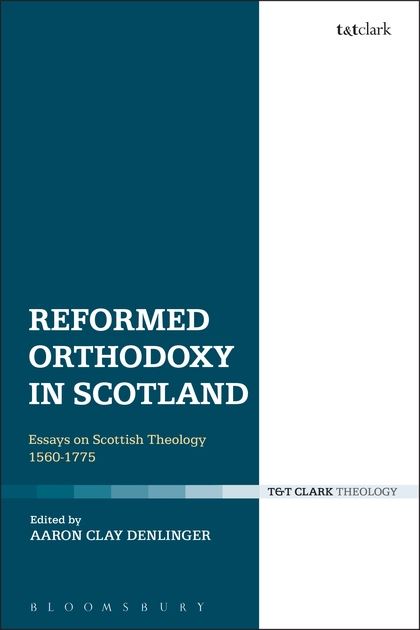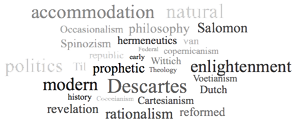Reformed Orthodoxy in Scotland: Essays on Scottish Theology 1560-1775, edited by Aaron Clay Denlinger. London/New York: Bloomsbury T&T Clark, 2015. 304 pages.
The section on Late Orthodoxy is opened by Paul Helm (MA, University of Oxford; Teaching Fellow at Regent College, Vancouver, Canada). In his essay, Helm compares Thomas Halyburton (1674-1712) with John Locke on their views concerning the grounding of faith in Scripture. Before he actually gets to their positions, however, Helm provides a brief sketch of the traditional teaching in Calvin, Turretin, and Owen. When it comes to establishing the divine authority of scripture, all of them distinguished between external (e.g. Scripture’s antiquity) and internal arguments (i.e. the consistency & harmony of its doctrine). While they conceded some force to the former arguments, they held that only the latter yield infallible certainty. When bringing Locke into the picture, Helm carefully notes the differences regarding intellectual and political context. Helm argues, that Locke sought to strike a middle way between the Roman-Catholic view and the enthusiasm of the Quakers. Against the latter movement, Locke strongly emphasized the necessity of ‘external arguments’ in order to justify any claim to divine revelation. In fact, his position left no room for internal arguments as traditionally understood by the Reformed Orthodox. It was this deviation from the older position that Halyburton criticized ardently arguing for the legitimacy and importance of the internal arguments. Helm’s essay is well-written and cogently argued. It is a pity, however, that the arguments by which Halyburton sought to evade the charge of ‘enthusiasm’ are only briefly touched on towards the end of the essay.
In chapter thirteen Richard A. Muller (PhD, Duke University; P.J. Zondervan Professor of Historical Theology at Calvin Theological Seminary in Grand Rapids, Michigan, USA) devotes himself to the theological program of Thomas Blackwell (1660-1728) as it expresses itself in his three major works Ratio Sacra (1710), Schema Sacrum (1710), and Methodus Evangelica (1712). As Muller demonstrates, the Ratio Sacra is mainly directed against Burignonism and Deism. In it, Blackwell seeks to defend Orthodox Christianity by arguing that true, revealed religion does not conflict with “natural reason properly exercised.” By applying this rationalistic approach, Muller holds, “he stepped beyond the typical sense of the limits of reason characteristic of the older orthodoxy.” (241) Having discussed the Ratio, Muller goes on to briefly analyze the Schema and the Methodus with frequent reference to the Marrow controversy that broke out less than a decade after these works were published. Muller’s portrait of Blackwell’s theological program is an important contribution to our understanding of Late Orthodoxy in Scotland (and beyond) in that it brings into focus the intellectual currents at the beginning of the eighteenth century. Yet, Muller’s treatment also clearly shows that much more research is necessary in this area, particularly when it comes to the vague notion of “rationalism”. For instance, Muller classifies Blackwell’s approach as “rationalizing” and at times even as “rationalistic”, while at the same time emphasizing his firm “anti-rationalist” polemic against Deism, his aversion to “full-blown rationalism” and the fact that Blackwell’s approach “did not arise out of an espousal of rationalist philosophy.”
The final contribution comes from the pen of Gerrit A. van den Brink (Drs. Utercht University; PhD candidate at the Evangelical Theological Faculty, Leuven, Belgium) and deals with Alexander Comrie’s controversial concept of faith as it is expressed in his commentary on the Heidelberg Catechism (1753). Van den Brink argues, that Comrie’s account exhibits striking similarities to that of the new England minister and theologian John Cotton (1585-1652), particularly when it comes to the relation between faith and union with Christ, justification, and the imputation of Christ’s righteousness to the believer. Although Comrie does not mention Cotton by name, these similarities suggest that Comrie deliberately drew on Cotton’s work when developing his concept of faith. Later, in the nineteenth century prominent Dutch theologians like Abraham Kuyper and Herman Bavinck, in turn, adopted a ‘Cottonian’ view on faith as they stood under the influence of Comrie’s work. Thus, Van den Brink’s essay fittingly concludes this volume as it demonstrates the international nature of Reformed Scholastic discourse and the lively involvement of Scottish theologians. Moreover, it points to the abiding impact of Reformed Scholasticism on modern theology.
Having discussed each chapter in turn, I want to conclude this book review with an overall assessment of this volume. No doubt, this is a valuable contribution to the ongoing reassessment of Reformed Orthodoxy. Denlinger has assembled a fine collection of essays written by both established experts and aspiring young scholars. Obviously, It belongs to the nature of such collections that there are stronger and weaker contributions. The present volume is no exception in that regard. Similarly, these kinds of projects can hardly be criticized for not being comprehensive given the breadth of the topic. Yet, in light of the fact that there are two contributions dealing with Rutherford, one may wonder why other important scholastics like Johannes Scharpius (1572–1648) are completely left out of the picture. One of the strengths of the “new school” approach is its eagerness to abandon the well-trodden paths of older scholarship by studying figures who (for some reason or another) have been neglected by modern scholarship regardless of their considerable fame and impact in their own life-times. This eagerness is, less visible in this volume. Moreover, its accessibility could have been improved by an extended introduction. A brief sketch of the major intellectual currents, the academic landscape, key political and societal developments etc. could have provided the (non-expert) reader with the necessary context helping him to better appreciate the individual contributions. That being said, I would recommend this volume to anyone interested in Scottish Reformed Orthodoxy. Those with a preference for digital texts (or with a low budget) will appreciate the fact that the PDF ebook is significantly cheaper (List price: $39.95) than the printed book (List price: $130.00). The kindle edition (around $20) is even cheaper, but not recommended for academic purposes as it does not contain real page numbers.


